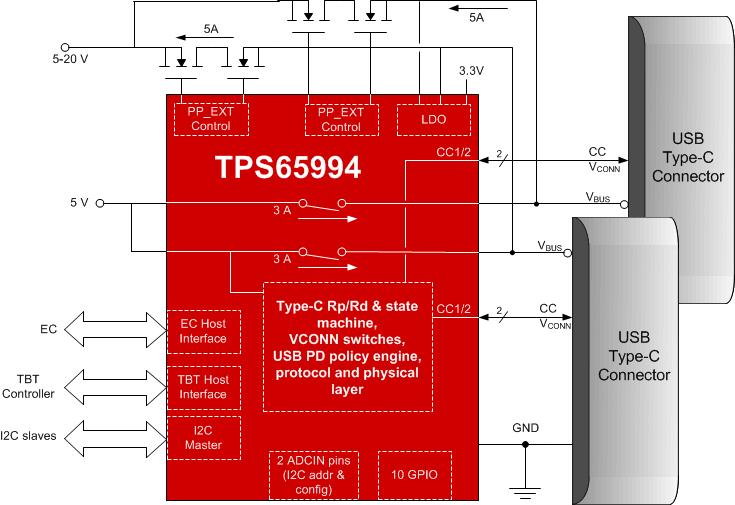JAJSJT6A August 2020 – July 2021 TPS65994AD
PRODUCTION DATA
- 1 特長
- 2 アプリケーション
- 3 概要
- 4 Revision History
- 5 Pin Configuration and Functions
-
6 Specifications
- 6.1 Absolute Maximum Ratings
- 6.2 ESD Ratings
- 6.3 Recommended Operating Conditions
- 6.4 Recommended Capacitance
- 6.5 Thermal Information
- 6.6 Power Supply Characteristics
- 6.7 Power Consumption
- 6.8 PP_5V Power Switch Characteristics
- 6.9 PP_EXT Power Switch Characteristics
- 6.10 Power Path Supervisory
- 6.11 CC Cable Detection Parameters
- 6.12 CC VCONN Parameters
- 6.13 CC PHY Parameters
- 6.14 Thermal Shutdown Characteristics
- 6.15 ADC Characteristics
- 6.16 Input/Output (I/O) Characteristics
- 6.17 I2C Requirements and Characteristics
- 6.18 Typical Characteristics
- 7 Parameter Measurement Information
-
8 Detailed Description
- 8.1 Overview
- 8.2 Functional Block Diagram
- 8.3
Feature Description
- 8.3.1 USB-PD Physical Layer
- 8.3.2 Power Management
- 8.3.3
Power Paths
- 8.3.3.1
Internal Sourcing Power Paths
- 8.3.3.1.1 PP_5Vx Current Clamping
- 8.3.3.1.2 PP_5Vx Local Overtemperature Shut Down (OTSD)
- 8.3.3.1.3 PP_5Vx Current Sense
- 8.3.3.1.4 PP_5Vx OVP
- 8.3.3.1.5 PP_5Vx UVLO
- 8.3.3.1.6 PP_5Vx Reverse Current Protection
- 8.3.3.1.7 Fast Role Swap
- 8.3.3.1.8 PP_CABLE Current Clamp
- 8.3.3.1.9 PP_CABLE Local Overtemperature Shut Down (OTSD)
- 8.3.3.1.10 PP_CABLE UVLO
- 8.3.3.2 Sink Path Control
- 8.3.3.1
Internal Sourcing Power Paths
- 8.3.4 Cable Plug and Orientation Detection
- 8.3.5 Default Behavior Configuration (ADCIN1, ADCIN2)
- 8.3.6 ADC
- 8.3.7 DisplayPort Hot-Plug Detect (HPD)
- 8.3.8 Digital Interfaces
- 8.3.9 Digital Core
- 8.3.10 I2C Interface
- 8.4 Device Functional Modes
- 9 Application and Implementation
- 10Power Supply Recommendations
- 11Layout
- 12Device and Documentation Support
- 13Mechanical, Packaging, and Orderable Information
3 概要
TPS65994AD は、PC およびノートPC アプリケーション向けの高集積スタンドアロン・デュアル・ポート USB Type-C および PD (Power Delivery) コントローラです。TPS65994AD は、完全に管理されたソース・パスと堅牢な保護機能を統合することで包括的な USB-C PD ソリューションを実現しています。 TPS65994AD このデバイスは、インテルと AMD の PC およびノート PC 最終製品リファレンス・デザインに採用されています。このリファレンス・デザインは、この種の設計において本 PD コントローラがシステム・レベルで適切に機能することを保証しています。これにより、システム設計の複雑さが大幅に緩和され、その結果、開発期間を大幅に短縮できます。
製品情報
| 部品番号(1) | パッケージ | 本体サイズ (公称) |
|---|---|---|
| TPS65994AD | QFN (RSL) | 6.0mm × 6.0mm |
(1) 利用可能なすべてのパッケージについては、このデータシートの末尾にある注文情報を参照してください。
